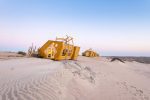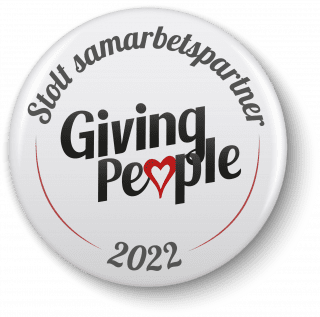If you are into luxury camping or “glamping”, preferring to travel “off the beaten track” and have an interest in animals and nature – well then this is the trip for you. Welcome to Kaokoveld, a dry and hilly area of Namibia up to the border with Angola. Here you will find beautiful wildlife with giraffes, desert elephants, black rhinos, various reptiles and many bird species. Afterwards, you move on to the wild skeletal coast, a different and beautiful part of the coast of Africa, where you can experience eg seal and flamingo colonies, hyenas, desert lions and elephants. But here are also opportunities for other adventures: take a ride in a four-wheel drive to see the shipwrecks of Suiderkus and Karimona, get past the remains of Westie’s diamond mine and more. End your adventure in Cape Town at a super delicious eco-hotel.
Contact form

Ecorating: 3.5
This product meets our requirements for Ecorating, a product that is good for humans and the environment.
Does my trip make a difference?
Read more
This product meets our requirements for Ecorating, a product that is good for humans and the environment.
Sample Itinerary

Welcome to Namibia!
You land in Windhoek, the capital of Namibia. Your driver is waiting for you and will take you to your hotel. Relax and recharge your batteries.

Today you fly on to the area of Kaokoveld, which also extends into neighboring Angola. This is a dry, hilly and completely unknown region for most non-Namibians. The area is made up of people from three different ethnic groups: Damara, Herero and the Himba people – all with their own traditions and rituals.
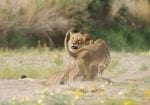
In a country with so many large, beautiful and impressive landscapes, Kaokoland is perhaps the most beautiful of them all. We are very far away from the main road in the northwest of Namibia with mountains, large sand dunes and desert, here is a fascinating wildlife and here and there small nomadic clusters of Himba people. It is a unique environment, a wild environment and a place that few people visit during their lifetime. Enjoy every moment!
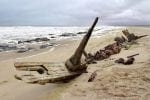
We have one last breakfast in the Hoanib Valley before embarking on adventures along the Skeleton Coast and to Shipwreck Lodge. The lodge is uniquely designed as one of the old shipwrecks you will see along the coast. This is a raw, robust and special place, a piece of wilderness where plains extend as far as the eye can reach. The Atlantic Ocean rolls in over the coast, sometimes calm and soothing, from time to time with a raging force.

But here is more than just wild nature. When staying at Shipwreck Lodge you can go on safari to spot desert elephants and lions. Many people are fascinated by the flora of the desert, where succulents and different kinds of moss are some of the most common. Look out over the landscape as the sun goes down, walk along the beach to look for traces of elephants, living or dead – and of the many ships that have ended their days here.
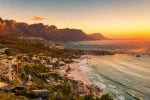
We eat our last breakfast in Namibia before we fly on to South Africa – to Cape Town. The beauty of the city combined with the local passion for good food and wine, makes this a perfect resort. If you want to go on a little wilder adventure, it can also be done. There are also many beaches, here is culture, shopping and everything else a big city has to offer.

Suggestions for what to do during your stay in Cape Town:
* Table Mountain Cable Way goes from the foot of the mountain and up to the top, a spectacular experience with the most beautiful views.
* Robben Island: Robben Island is the island where Nelson Mandela was imprisoned for 27 years!
* Township Cultural Tours: A fantastic opportunity to see the city’s townships (or in the good Danish slums). But here is more than poverty and problems, which your local guide can tell you about. Maybe you eat a good meal here at a typical little restaurant called a “sheebeen”. An experience that puts your / our own life here in prosperous Scandinavia in perspective.
* District Six Museum: Get to know more about life in South Africa during apartheid.
* Cape Point and Cape of Good Hope.
* Boulders Beach: Penguin Colonies.
* Hout Bay: Boat trip to the seal colony
* Cape Peninsula: A world famous botanical area with impressive wildlife. Here you can see baboons, ostriches, bontebok antelope, lots of birds and maybe even whales.
* Kirstenbosch Botanical Gardens.
Trip details
When can you travel?All year round but it can be very hot in December and January. The coldest are in June and July.
Airport: Windhoek (WDH)
Length: 8 nights – can be extended
Price includes: International round trip flight, full board at the safari lodges and breakfast at the hotels in Windhoek and Ellerman House, all activities in the program, transfer to and from airports.
Price does not include: Travel insurance, tips, extra activities and meals outside the planned program.
Good to know about Namibia:
Mobile coverage and internet: Coverage in the larger hotels but not during your stay in the desert
Visas: Danish citizens do not need visa but your passport must be valid for a minimum of 6 months from entry. There must be at least two blank pages in the passport passport.
Time zone: GMT + 1
Vaccinations: Read more at Statens Serum Institut
Local currency: Namibian dollar
Weather: Windhoek, Namibia
Water: Clean water in the camp and in the hotels
Safety: Good

Ecorating: 3.5
This product meets our requirements for Ecorating, a product that is good for humans and the environment.
Does my trip make a difference?
Read more
This product meets our requirements for Ecorating, a product that is good for humans and the environment.
Hoanib Valley Camp & Shipwreck Lodge
Over the past 30 years, Natural Selections has been one of the most innovative in developing new, unique safari experiences. The purpose of the company is not only to get you to the place where you can see elephants, but to show you the best that Africa has to offer in terms of nature, people, environment and culture. They want you to immerse yourself in nature and to relive what it feels like to be on a real adventure. And most importantly: you need to return home with stories that your children and grandchildren like to listen to over and over again.
At Hoanib Valley Camp and Shipwreck Lodge, one does not really want to own or conquer nature or the surroundings. You want to connect with the communities you live close to. Therefore, the lodges should not dominate the landscape, but be a part of it. The lodges are often run in joint partnerships with the local community. 1.5% of all revenue goes to various projects within ecology, sustainable development and other, similar projects across Africa.
Ellerman House
It supports projects such as Art angels, The Click Foundation and the Great Plains Conservation – all projects aimed at helping the local community. The hotel wants to be Cape Town’s most environmentally friendly boutique hotel, and they work with various techniques within solar cell technology, low-energy light bulbs, heat pumps, worm farms and recycling systems. You want to be the city’s greenest luxury hotel, and you want to inspire others to go in the same direction.
“We have a responsibility to our guests and our neighbors here in the city – a responsibility that is about our common future. I know that the entire Ellerman House is behind that decision and that responsibility”Ella Cuyler, Hotel Manager
All energy consumption in the hotel’s various departments is measured throughout the day, to see how consumption is distributed and how to optimize it. Among other things, 1,500 sensors have been installed, which switch lights on and off depending on whether there is activity in the room or room in question. This has saved 80% of the total electricity consumption.
The hotel’s photovoltaic system produces 40% of all the electricity used, including 230 solar panels and a new car park with solar – powered carports.
Ellerman House has always cultivated recycling and recycling, but it is planned to take the activities a little further. Organic waste is composted, and the topsoil is used in the garden, where local and not least drought-tolerant plants have been planted.
Ellerman House uses a heat pump to produce hot water.
